【6s965-fall2022】量化 Quantization Ⅰ
| 阿里云国内75折 回扣 微信号:monov8 |
| 阿里云国际,腾讯云国际,低至75折。AWS 93折 免费开户实名账号 代冲值 优惠多多 微信号:monov8 飞机:@monov6 |
模型的大小不仅和参数量的多少有关而且也和位宽有关。
M o d e l S i z e = # P a r a m e t e r × B i t W i d t h . ModelSize = \#Parameter × BitWidth. ModelSize=#Parameter×BitWidth.
低位宽的运算操作容易实现、运算速度快、功耗低。

什么是量化
从广义上讲量化是将连续信号变成离散信号的过程它在信号处理以离散的时间间隔采样和图像压缩减少每个像素的可能颜色空间中很常见。

在这门课中我们将量化定义为将输入从一个连续的、大范围的数值集约束为一个离散的、小范围的数值集的过程。量化的过程包括将每个权重的数据类型改为限制性更强的数据类型即可以用更少的比特表示。常用的量化方法有基于K-Means的权重量化K-Means Based Weight Quantization和线性量化Linear Quantization。
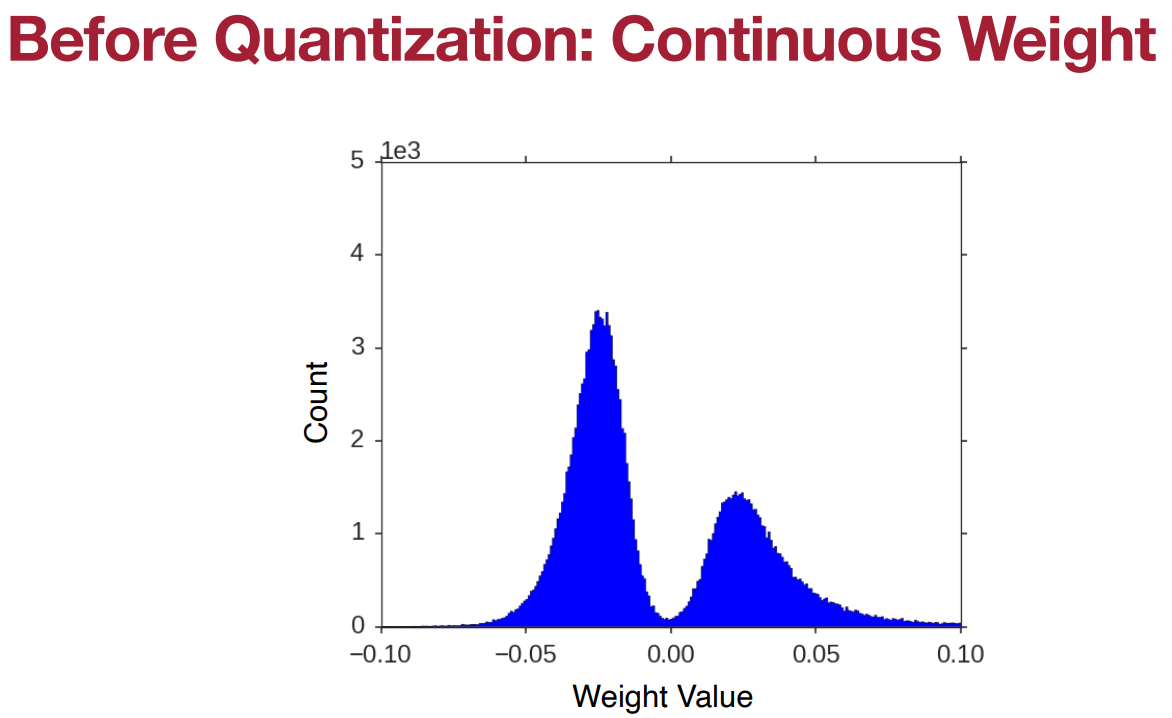
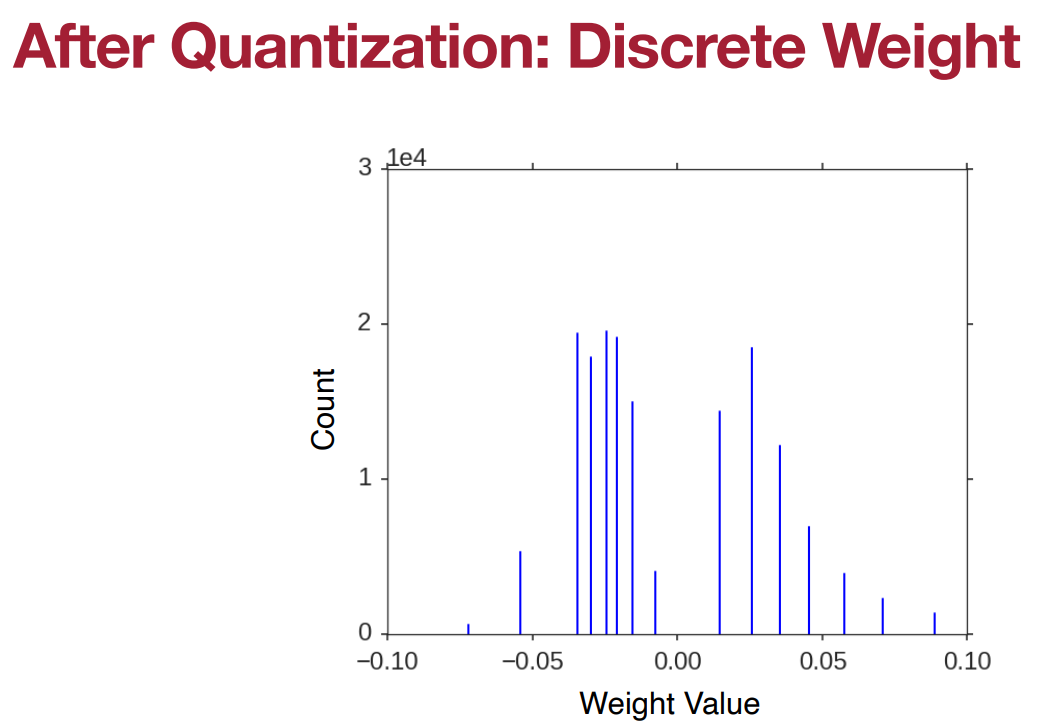

数据类型
- 整数Integers
- 原码Signed-Magnitude
- 反码Ones’ Complement
- 补码Two’s Complement
- 定点数Fixed Point Numbers
- 浮点数Floating Point Numbers
- ( − 1 ) sign × ( 1. mantissa ) + 2 exponent − exponent bias (-1)^{\text{sign}} \times (1.\text{mantissa}) + 2^{\text{exponent} - \text{exponent bias}} (−1)sign×(1.mantissa)+2exponent−exponent bias
| Convention | Sign Bits | Exponent Bits | Mantissa Bits |
|---|---|---|---|
| IEEE 754 | 1 | 8 | 23 |
| IEEE Half-Precision 16-bit float | 1 | 5 | 10 |
| Brain Float (BF16) | 1 | 8 | 7 |
| NVIDIA TensorFloat 32 | 1 | 8 | 10 |
| AMD 24-bit Float (AMD FP24) | 1 | 7 | 16 |
Brain Float (BF16) 是专门为神经网络而设计的数据类型对比于IEEE Half-Precision 16-bit float 更加看重范围精度不如范围重要。
基于K-Means的权重量化
K-Means-based Weight Quantization [Han et al., ICLR 2016]
正如Brain Float (BF16) 所考虑的那样神经网络的性能实际上并不太依赖于权重的精度。一般来说像2.09、2.12、1.92和1.87这样的值都可以被近似为2那么我们为什么不把权重近似成这样呢
方法将权重聚类为 n n n个类别使用K-Means聚类算法其中 n n n通常为 2 2 2的某个幂。然后用每个类别中所有权重的平均值来近似该类别对应的权重。将类别的ID与值的存储在一个编码表codebook中生成一个索引矩阵。
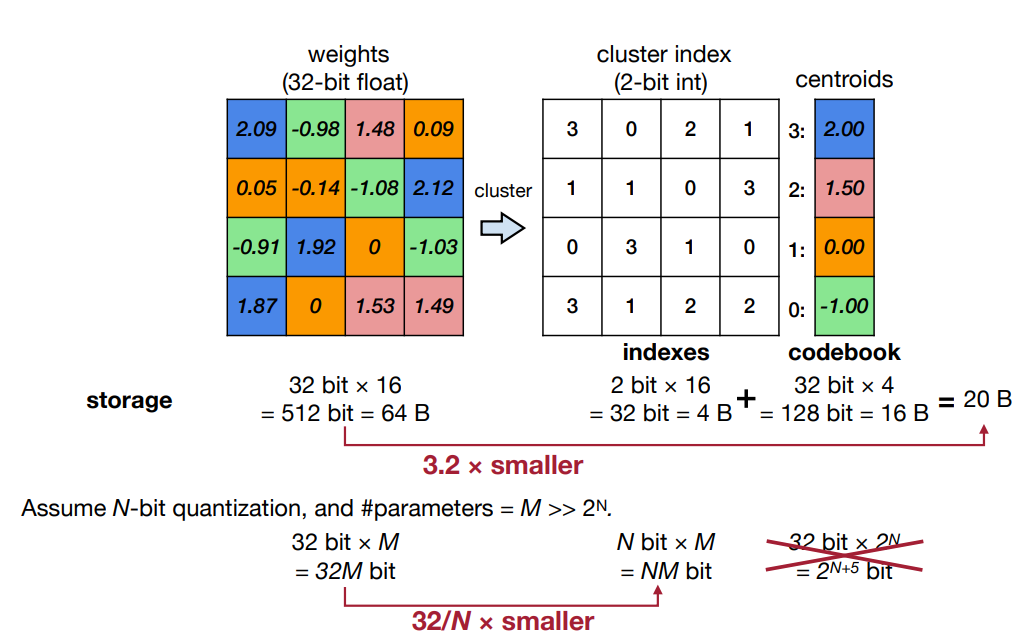
在存储压缩率方面设
N
0
N_0
N0为每个权重的原始比特数
n
n
n为用于聚类的个数(
n
=
2
N
1
n=2^{N_1}
n=2N1)
M
M
M为权重的数量。那么压缩率约为
M
∗
log
2
n
+
N
0
∗
n
M
∗
N
0
\frac{M*\log_2n + N_0*n}{M*N_0}
M∗N0M∗log2n+N0∗n。一般来说随着模型规模的增大即
M
→
∞
M\rightarrow\infty
M→∞压缩率接近
l
o
g
2
n
N
0
\frac{log_2n}{N_0}
N0log2n。
在推理过程中要根据编码表codebook将索引矩阵中的类别id替换成它们所代表的权重才可进行正常的浮点运算。
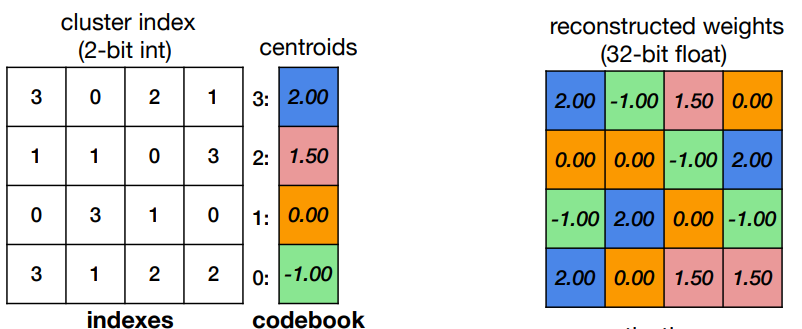
如果你想对模型进行微调那么你只需执行梯度下降参数为编码表条目。一般来说将每个类别中每个权重的梯度聚合sum、mean就可以得到整个类别的梯度进而可以更新编码表条目。
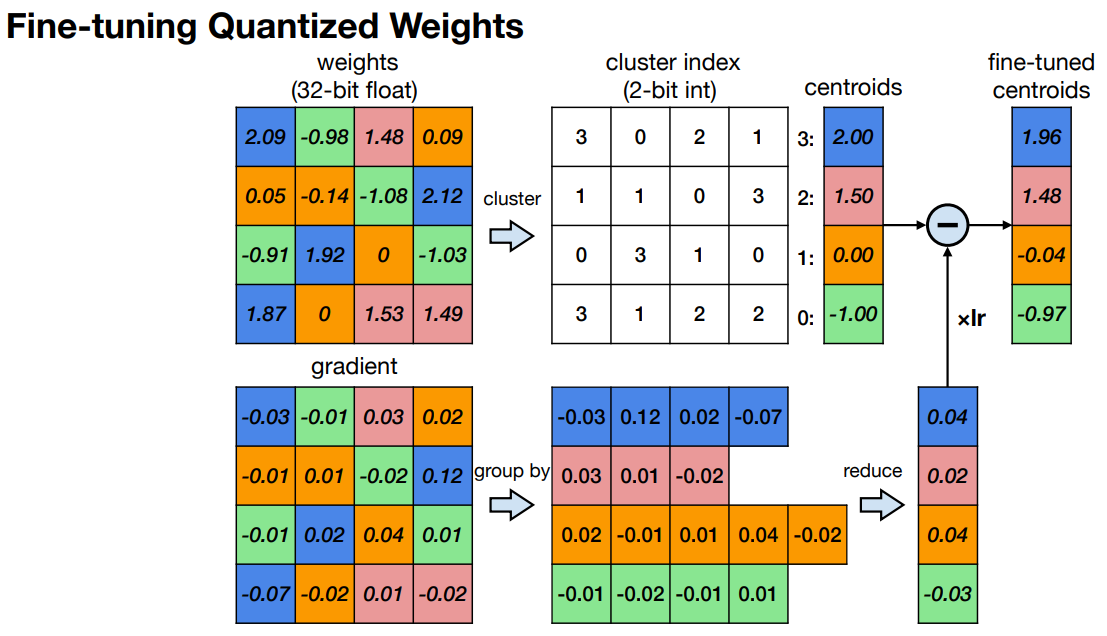
另一个需要注意的是如果你想同时对一个模型进行修剪和量化一般的做法是先修剪后量化。
挑战极限
超参数选择唯一需要选择的超参数是编码簿codebook条目的数量一般来说标准做法是使用16个AlexNet的实验表明卷积层需要4位全连接层需要2位才会出现明显的准确性下降。奇怪的是这些阈值与模型是否先被修剪无关。

SqueezeNet一般来说人们会问为什么我们不一开始就训练压缩模型SqueezeNet的创造者们决定试一试。再加上剪枝和量化该模型取得了510倍的可笑的压缩率同时保持了AlexNet的Top-1和Top-5的准确值。
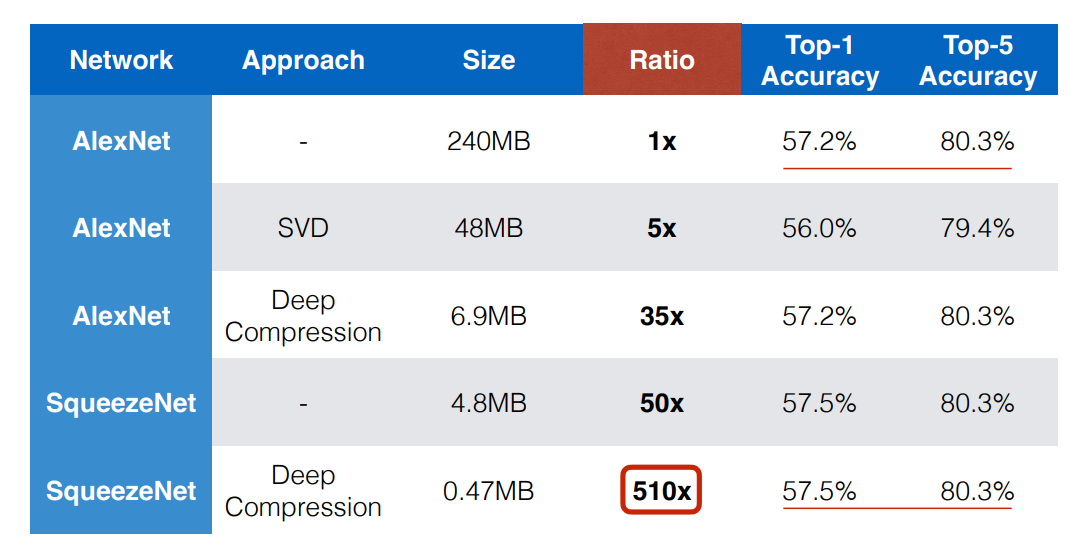
哈夫曼编码我们做了一个隐含的假设即所有的类别索引id都必须由相同数量的比特来表示。但是很明显有些类别索引id会比其他的使用更加频繁。为什么我们不对使用更频繁的类别索引id使用较少的比特呢使用哈夫曼编码就可以做到这一点并且可以进一步提高压缩率。

深度压缩 (Deep Compression)
Deep Compression: Compressing Deep Neural Networks With Pruning, Trained Quantization And Huffman Coding
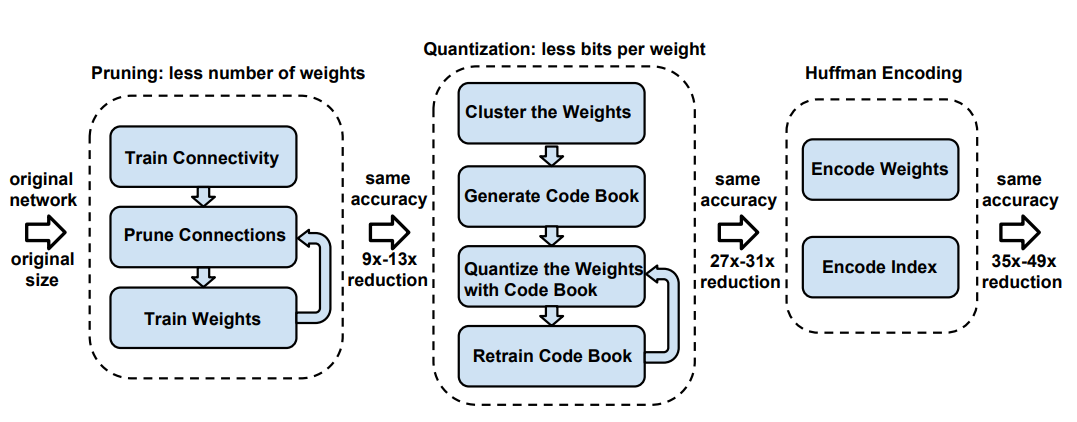

实现
安装需要的库
!pip install torchprofile
!pip install fast-pytorch-kmeans
一个
n
n
n位的k-means量化将把权重分成
2
n
2^n
2n个类别同一类别中的权重将共享相同的权重值。因此k-means量化将创建一个codebook其中包括
centroidsc2 n 2^n 2n fp32聚类中心。labels一个 n n n位的整数张量与原始fp32权重张量的元素个数相同。每个整数表示它属于哪个簇。
在推理过程中根据codebook生成一个fp32张量。
quantized_weight = codebook.centroids[codebook.labels].view_as(weight)
from collections import namedtuple
from fast_pytorch_kmeans import KMeans
Codebook = namedtuple('Codebook', ['centroids', 'labels'])
def k_means_quantize(fp32_tensor: torch.Tensor, bitwidth=4, codebook=None):
"""
quantize tensor using k-means clustering
:param fp32_tensor:
:param bitwidth: [int] quantization bit width, default=4
:param codebook: [Codebook] (the cluster centroids, the cluster label tensor)
:return:
[Codebook = (centroids, labels)]
centroids: [torch.(cuda.)FloatTensor] the cluster centroids
labels: [torch.(cuda.)LongTensor] cluster label tensor
"""
if codebook is None:
# get number of clusters based on the quantization precision
n_clusters = 1 << bitwidth
# use k-means to get the quantization centroids
kmeans = KMeans(n_clusters=n_clusters, mode='euclidean', verbose=0)
labels = kmeans.fit_predict(fp32_tensor.view(-1, 1)).to(torch.long)
centroids = kmeans.centroids.to(torch.float).view(-1)
codebook = Codebook(centroids, labels)
# decode the codebook into k-means quantized tensor for inference
quantized_tensor = codebook.centroids[codebook.labels]
fp32_tensor.set_(quantized_tensor.view_as(fp32_tensor))
return codebook
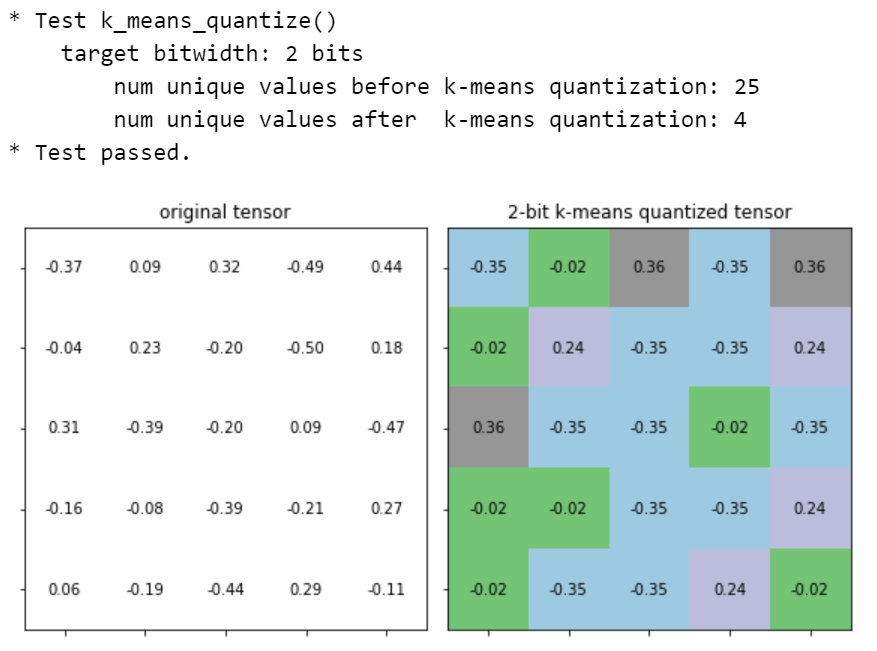
现在将k-means量化函数包装成一个用于量化整个模型的类。在 "KMeansQuantizer "类中我们必须保持codebook即 "中心点 "和 “标签”的记录这样我们就可以在模型权重改变时应用或更新codebook。
from torch.nn import parameter
class KMeansQuantizer:
def __init__(self, model : nn.Module, bitwidth=4):
self.codebook = KMeansQuantizer.quantize(model, bitwidth)
@torch.no_grad()
def apply(self, model, update_centroids):
for name, param in model.named_parameters():
if name in self.codebook:
if update_centroids:
update_codebook(param, codebook=self.codebook[name])
self.codebook[name] = k_means_quantize(
param, codebook=self.codebook[name])
@staticmethod
@torch.no_grad()
def quantize(model: nn.Module, bitwidth=4):
codebook = dict()
if isinstance(bitwidth, dict):
for name, param in model.named_parameters():
if name in bitwidth:
codebook[name] = k_means_quantize(param, bitwidth=bitwidth[name])
else:
for name, param in model.named_parameters():
if param.dim() > 1:
codebook[name] = k_means_quantize(param, bitwidth=bitwidth)
return codebook
对模型进行量化
bitwidth = 8
quantizer = KMeansQuantizer(model, bitwidth)
当模型量化到较低的比特时准确率明显下降。因此我们必须进行训练以恢复准确性。在k-means量化感知训练期间中心点也会被更新中心点的梯度计算如下。
∂ L ∂ C k = ∑ j ∂ L ∂ W j ∂ W j ∂ C k = ∑ j ∂ L ∂ W j 1 ( I j = k ) \frac{\partial \mathcal{L} }{\partial C_k} = \sum_{j} \frac{\partial \mathcal{L} }{\partial W_{j}} \frac{\partial W_{j} }{\partial C_k} = \sum_{j} \frac{\partial \mathcal{L} }{\partial W_{j}} \mathbf{1}(I_{j}=k) ∂Ck∂L=∑j∂Wj∂L∂Ck∂Wj=∑j∂Wj∂L1(Ij=k)
其中 L \mathcal{L} L是损失 C k C_k Ck是k个中心点 I j I_{j} Ij是权重 W j W_{j} Wj的标签。 1 ( ) \mathbf{1}() 1()是指标函数 1 ( I j = k ) \mathbf{1}(I_{j}=k) 1(Ij=k)意味着 1 i f I j = k e l s e 0 1\;\mathrm{if}\;I_{j}=k\;\mathrm{else}\;0 1ifIj=kelse0即 I j = = k I_{j}==k Ij==k。
为了简单起见我们直接根据最新的权重更新中心点
C k = ∑ j W j 1 ( I j = k ) ∑ j 1 ( I j = k ) C_k = \frac{\sum_{j}W_{j}\mathbf{1}(I_{j}=k)}{\sum_{j}\mathbf{1}(I_{j}=k)} Ck=∑j1(Ij=k)∑jWj1(Ij=k)
def update_codebook(fp32_tensor: torch.Tensor, codebook: Codebook):
"""
update the centroids in the codebook using updated fp32_tensor
:param fp32_tensor: [torch.(cuda.)Tensor]
:param codebook: [Codebook] (the cluster centroids, the cluster label tensor)
"""
n_clusters = codebook.centroids.numel()
fp32_tensor = fp32_tensor.view(-1)
for k in range(n_clusters):
codebook.centroids[k] = fp32_tensor[codebook.labels == k].mean()
训练
accuracy_drop_threshold = 0.5
quantizers_before_finetune = copy.deepcopy(quantizers)
quantizers_after_finetune = quantizers
for bitwidth in [8, 4, 2]:
recover_model()
quantizer = quantizers[bitwidth]
print(f'k-means quantizing model into {bitwidth} bits')
quantizer.apply(model, update_centroids=False)
quantized_model_size = get_model_size(model, bitwidth)
print(f" {bitwidth}-bit k-means quantized model has size={quantized_model_size/MiB:.2f} MiB")
quantized_model_accuracy = evaluate(model, dataloader['test'])
print(f" {bitwidth}-bit k-means quantized model has accuracy={quantized_model_accuracy:.2f}% before quantization-aware training ")
accuracy_drop = fp32_model_accuracy - quantized_model_accuracy
if accuracy_drop > accuracy_drop_threshold:
print(f" Quantization-aware training due to accuracy drop={accuracy_drop:.2f}% is larger than threshold={accuracy_drop_threshold:.2f}%")
num_finetune_epochs = 5
optimizer = torch.optim.SGD(model.parameters(), lr=0.01, momentum=0.9)
scheduler = torch.optim.lr_scheduler.CosineAnnealingLR(optimizer, num_finetune_epochs)
criterion = nn.CrossEntropyLoss()
best_accuracy = 0
epoch = num_finetune_epochs
while accuracy_drop > accuracy_drop_threshold and epoch > 0:
train(model, dataloader['train'], criterion, optimizer, scheduler,
callbacks=[lambda: quantizer.apply(model, update_centroids=True)])
model_accuracy = evaluate(model, dataloader['test'])
is_best = model_accuracy > best_accuracy
best_accuracy = max(model_accuracy, best_accuracy)
print(f' Epoch {num_finetune_epochs-epoch} Accuracy {model_accuracy:.2f}% / Best Accuracy: {best_accuracy:.2f}%')
accuracy_drop = fp32_model_accuracy - best_accuracy
epoch -= 1
else:
print(f" No need for quantization-aware training since accuracy drop={accuracy_drop:.2f}% is smaller than threshold={accuracy_drop_threshold:.2f}%")
结果
k-means quantizing model into 8 bits
8-bit k-means quantized model has size=8.80 MiB
8-bit k-means quantized model has accuracy=92.75% before quantization-aware training
No need for quantization-aware training since accuracy drop=0.20% is smaller than threshold=0.50%
k-means quantizing model into 4 bits
4-bit k-means quantized model has size=4.40 MiB
4-bit k-means quantized model has accuracy=84.01% before quantization-aware training
Quantization-aware training due to accuracy drop=8.94% is larger than threshold=0.50%
Epoch 0 Accuracy 92.29% / Best Accuracy: 92.29%
Epoch 1 Accuracy 92.47% / Best Accuracy: 92.47%
k-means quantizing model into 2 bits
2-bit k-means quantized model has size=2.20 MiB
2-bit k-means quantized model has accuracy=12.26% before quantization-aware training
Quantization-aware training due to accuracy drop=80.69% is larger than threshold=0.50%
Epoch 0 Accuracy 90.29% / Best Accuracy: 90.29%
Epoch 1 Accuracy 91.06% / Best Accuracy: 91.06%
Epoch 2 Accuracy 91.22% / Best Accuracy: 91.22%
Epoch 3 Accuracy 91.44% / Best Accuracy: 91.44%
Epoch 4 Accuracy 91.33% / Best Accuracy: 91.44%

